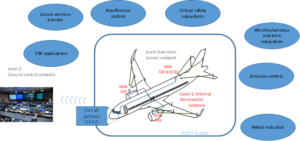The number of wireless connections is growing exponentially around the globe. It is estimated that nearly 25 billion devices will be connected to the Internet by 2020 and 50 billion devices by the year 2050. A high percentage of these devices will use some sort of wireless connection. Wireless is expanding to areas previously reluctant to the use of this type of communication. In aeronautics, wireless is just recently gaining acceptance for on-board applications. This late adoption is mainly because of its operation has been conventionally associated with reliability and interference issues. Wireless technology is starting to be used on board for systems that conventionally used only wire-line infrastructure (i.e., as replacement of wires). It will be also used for applications which are now only possible thanks to the wireless component (e.g., indoor localization). Recent interference and reliability studies with state-of-the-art wireless standards suggest the feasibility of a relatively new research area that has been called wireless avionics intra-communications (WAICS). Examples of potential applications of wireless avionics intra-communications are the following: structure health monitoring, fuel tank sensors, automatic route control based on optimized fuel consumption and weather monitoring, automatic turbulence reduction or active flow control, flexible wiring redundancy design, logistics, and broadband in-flight entertainment systems. In addition, the areas of unmanned aerial vehicles (UAVs) and drones are opening new challenges for wireless networking and V2x communications.
The avionics industry will experience a wireless revolution in the years to come. The concept of “fly-by-wireless” opens several issues in design, configuration, security, trustiness, and interference control. This project attempts to fill many of these gaps in the literature and increase the technology readiness level of wireless solutions in the avionics industry. This involves plenty of efforts in the design of every layer of wireless technologies for aircrafts, including safe and secure operation, which are critical in this industry. Wireless networks are inherently prone to security and privacy threats due to their broadcast nature. Eavesdropping by unintended parties on board or outside the airplane is one of the main issues in aeronautics, which requires appropriate encryption, coding and/or authentication schemes to be minimized. Man-in-the-middle and denial of service (DoS) attacks can prevent sensor information about aircraft health from reaching the control cabin, thus posing a threat to the safety of the plane, leading to mal-functioning or incorrect operation. Intentional and unintentional jamming can also increase the risk of failure and lack of communication in aircraft. All these vulnerabilities and risks need to be properly studied, so that potential countermeasures can be implemented.
Summarizing, the objectives of this domain are as follows:
The objectives of SCOTT in terms of measurable indicators are:

